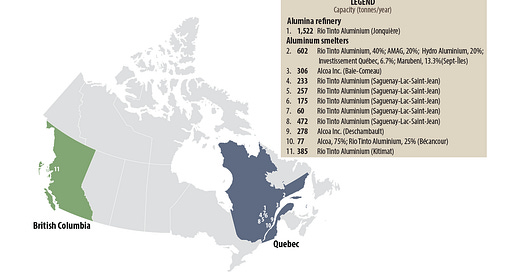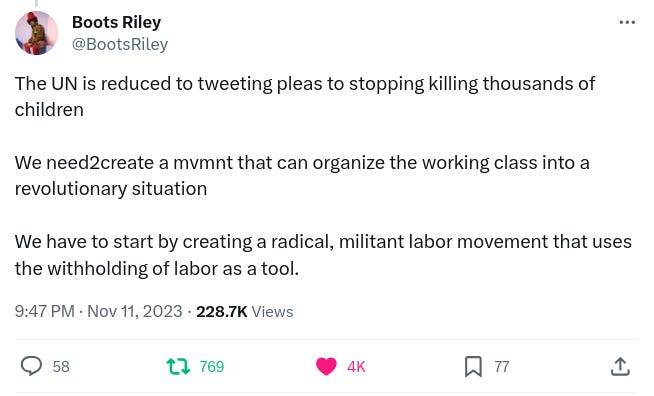The intertwined western military-industrial complex
From mining the metal to using it to kill people, a logistical spiderweb
Who is winning the propaganda war? Billionaires are planning to pump some serious money into the narrative battle. Good luck to them, I guess, but perhaps the US - and satellites in UK, Canada, France & Germany - overemphasize narrative and information and underemphasize the material world. Vaclav Smil has pointed out that “recently fashionable claims about the dematerialization of modern economies dominated by services and miniaturized electronic devices” are misleading. The global food system and the entire industrial economy depends on fossil fuels. In his book How the World Really Works, Smil identifies the “four pillars of modern civilization”. They aren’t facebook, twitter, google, and amazon: they are ammonia, steel, concrete, and plastics.
This isn’t the main point of what I want to talk about tonight so I will give you this long quote about why these four pillars and move on:
“…only an impossibly complete recycling of all wastes voided by grazing animals could, together with near-perfect recycling of all other sources of organic nitrogen, provide the amount of nitrogen annually applied to crops in ammonia-based fertilizers. Meanwhile, there are no other materials that can rival the combination of malleability, durability, and light weight offered by many kinds of plastics. Similarly, even if we were able to produce identical masses of construction lumber or quarried stone, they could not equal the strength, versatility, and durability of reinforced concrete. We would be able to build pyramids and cathedrals but not elegant long spans of arched bridges, giant hydroelectric dams, multilane roads, or long airport runways. And steel has become so ubiquitous that its irreplaceable deployment determines our ability to extract energies, produce food, and shelter populations, as well as ensuring the extent and quality of all essential infrastructures: no metal could, even remotely, become its substitute.”
The material world also cannot be neglected in the question of war. States (or armed groups) go to war to try to change a status quo. They apply military pressure on their enemy to try to get that enemy to comply with something. I’ve talked about the different strategies at play in a previous post.
Israel has destroyed most of Gaza’s hospitals and is trying to close in and destroy the big hospital in Gaza City. They claim (a claim no one but diehard pro-Israel people believe) that the hospital is the “Hamas command center”. Since everybody knows the hospital isn’t a command center, we have to look for Israel’s real objective in applying so much military pressure to hospitals and gathering sites specifically, targeting the already wounded and children sheltering for safety. The idea is probably to try to show that Israel (and its western backers) have no limits (as Israelis have declared many times - see this compilation by Norman Finkelstein) in the hope that this will create enough terror to psychologically break the Palestinian Resistance (which Westerners call “Hamas”). If the Palestinians aren’t broken psychologically, the strategy fails.
This is a dynamic of warfare between settler states and Indigenous populations, guerrilla warfare, politics and strategy - topics we have covered before, including in the book Siegebreakers, and will cover again.
Tonight though I want to talk about another aspect of modern warfare, which is that it involves the production of composite objects of plastic and metal run on fossil fuels (missiles, shells, bullets) and then blasted into people from other machines (planes, artillery pieces, various kinds of guns) to kill them. The production of these objects is a global effort of Western states and corporations that involves exploiting and destroying Indigenous lands, employing workers from many countries, passing through many logistical bottlenecks.
Consider a metal, well below the four pillars in overall importance, but of central importance to warfare: aluminum. In their 2010 book Out of This Earth: East India Adivasis and the Aluminium Cartel, Felix Padel and Samarendra Das reveal the entire web of connections from the destruction of the means of Indigenous survival at the point of extraction to the physical destruction of Indigenous people when the bombs are dropped. They cite Dewey Anderson’s 1951 pamphlet Aluminum for Defence and Prosperity, published by the US Public Affairs Institute. Anderson wrote that “Aluminum has become the most important single bulk material of modern warfare. No fighting is possible, and no war can be carried to a successful conclusion today, without using and destroying vast quantities of aluminum.” Aluminum “makes fighter and transport planes possible”, it is “needed in atomic weapons”... “yet aluminum is a scarce metal… government steps in for prolonged periods of time, determines how much aluminum there should be, expands production at government expense, and decides what part of the supply will be available for civilians.”
Aluminum is an interesting metal because its production requires the raw material bauxite and copious amounts of electricity. Out of this Earth describes it in terms analogous to a mathematical equation: aluminum = bauxite + electricity. Bauxite is generally found in the Global South and on aboriginal lands: the biggest bauxite deposits in 2001 were 1 - Guinea, 2 -Australia, 3 - Brazil, 4 - India, 5 - Jamaica, 6 - China and in tonnage mined per year in 2007 the top 5 were Australia, China, Brazil, Guinea, India, and Jamaica.
But that’s bauxite - just one of the two inputs. When you look at production of aluminum, it’s a different story: the top 5 in 2008 were China, Russia, the US, Canada, and Australia. By 2022 it was China, India, Russia, Canada and the UAE (the US was 9th). Canadian production was once owned by Alcan, which was the Canadian subsidiary of the US Alcoa. Alcan was purchased by the British-Australian mining company Rio Tinto in 2007. Of course, the bauxite-producing countries get fleeced, with their bauxite selling at a fraction of the price of the finished aluminum - that’s the first increment of imperialist value transfer at work.
Why is Canada in the top 5 at all, if it doesn’t have bauxite? Canada found its way into this crucial network of the Western military-industrial complex because of its hydroelectric capacity (you guessed it - located on Indigenous land, “hydroelectric capacity” being another word for life-giving river ecosystems where First Nations civilizations thrived for centuries).
BC and Quebec’s hydroelectricity is supplied cheaply to Rio Tinto and to Alcoa, one of numerous subsidies to the mining and military industries that keeps them profitable and that enables them to beautify the environment like this:
The electricity subsidy is another increment of value transfer, this time from Indigenous land to Global North corporations.
The final increment is when the shiny aluminum is used to make warplanes and missiles. At that final step, we see another huge increment in private profits and an equally complete integration between Canada and US military industries.
A 2016 article on Open Canada interviewing the peace institute Project Ploughshares described the “murky world of Canada’s arms manufacturing” and the Defence Production Sharing Agreement between Canada and the US, which “set up a special arrangement where military goods shipped between the U.S. and Canada are not required to go through the same system as everything else exported by the U.S. and do not require export permits by the Canadian government.” That’s why many of the top military producers in Canada on the Canadian Defence Review site are the same big US names: Lockheed Martin [Canada], Raytheon, General Dynamics [Canada], why you’ll see the same names on the Invest Ontario website.
Industry Ontario:
In the past month, organized by groups like World Beyond War, activists have done direct actions at companies like INKAS and L3 Harris. The organization has created a map of companies and their locations.
Once the global logistical chains of these murderous objects are revealed, it becomes almost overwhelming to decide on where to campaign. The above analysis for aluminum could be repeated for other basic materials, like white phosphorus - a particularly nasty chemical Israel’s army uses to burn kids in Gaza. Some quick research suggests that most of the phosphate used by the US is mined in Florida:
The environmental implications of phosphate mining are problematic, at least so the Washington Post found in 2021.
Mines, manufacturing facilities, and administrative offices are spread all over the West. The materials are trucked, railed, and shipped all over the place before they reach their final sites of death and destruction.
When majorities are organized, the whole murderous machinery could be halted by people simply putting their tools down in a general strike. Short of that, though, the leaders of direct actions in the West, Palestine Action, have argued for a sharp focus - theirs has been on Elbit Systems, Israel’s largest weapons supplier.
I’ll leave it there, but just with a little step back to the idea of building toward strike actions - let me quote Boots Riley, who apparently has a show called I’m a Virgo.
If stopping the genocide were entirely up to us, we would have to build up to this kind of people power. A movement that could take labor action and mass direct action to stop a genocide and then direct our labor to helping Palestinians rebuild every hospital, mosque, school, and house in Gaza more beautiful than before.
To stop a genocide it’s worth being a voice in the wilderness, but with large and growing numbers come greater opportunities.












Aotearoa/New Zealand is also part of this chain. We’ve had our biggest hydropower scheme at Manapouri in the middle of delicate rainforest, built with public funds but virtually owned by Riotinto and Sumitomo for 60 years. The bauxite comes from Australia and the aluminium originally exported to Japan but I think it goes to other places too now. Environmentalists fought hard to restrict the raising of Lake Manapouri in the building of the damn and won significant victories in the 1960’s and 70’s Anti-imperialists, especially the Campaign against Foreign Control Aotearoa, have fought for almost as long, again with some success, against secret piratical pricing arrangements for the smelter owners. The subservience of the capitalist state in the matter has been sickening.
Thanks especially for the insightful, inspirational last remarks. Sorely needed.